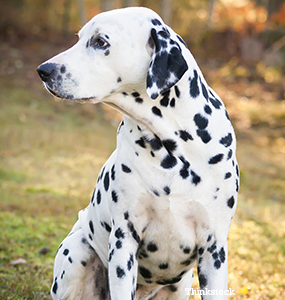Background:
The Dalmatian takes his name from the region of Dalmatia in the country known today as Croatia. The original breeding lines have long been a mystery and even in what capacity the Dalmatian was originally used is in dispute. Most likely the Dalmatian worked many different jobs: ratter, guard dog, hunter and trail dog.
In England the Dalmatian found his calling as a coach dog. He ran alongside the stagecoach watching for danger and clearing the path ahead of the coach. His unique appearance also offered an aesthetic appeal to the coach. Later the Dalmatian was adopted by many firehouses and given the additional responsibility of guarding the equipment at night.
With the invention of the automobile, Dalmatian numbers saw a steep decline. They rose again after he was featured in many modern day films.
The American Kennel Club recognized the Dalmatian in 1888.
Sizing up:
- Weight: Varies
- Height: 19 to 23 inches
- Coat: Short, fine and smooth
- Color: White with black or brown spots
- Life expectancy: 10 to 13 years
What’s the Dalmatian like?
The Dalmatian was bred to run alongside horses and his desire to run is no less powerful today than it was then. He would make a great choice as a jogging companion or even as a sprinter. If you have a Dalmatian, be prepared to exercise him frequently and every day. He won’t be content to sit in front of a roaring fire and nap (at least not all of the time). The Dalmatian is more interested in putting in a full day of effort just as his forbearers did. He hasn’t forgotten the days of service and could still be used for hunting or guiding if properly trained.
A healthy Dalmatian should be easy to train. His history shows us that he follows directions well and will obey a dominant leader. It’s always a good idea to train using both physical and verbal cues. This is especially true for the Dalmatian, as the breed is prone to hearing problems. A great example of a physical cue would be making a fist when you want the Dalmatian to sit. If you have horses you can use some of the same cues for both animals, (probably not “sit”).
The Dalmatian is likely to be reserved when in public and open up around his family. Shyness can be avoided with proper socialization. Make sure you introduce your Dalmatian to other dogs early in life and find classes whenever possible.
Above all else - realize that the Dalmatian is a people dog. He wants and needs to spend time with his family and makes an excellent guard dog.
Health:
Dalmatians are predisposed to hearing loss, it’s advisable that you have them tested early and discuss this concern with your breeder. (Not to imply that deaf dogs can’t be great dogs, but they are not generally recommended for a household with children.)
Dalmatians can also suffer from dilated cardiomyopathy and hyperuricemia.
Takeaway points:
- The Dalmatian is an energetic dog and will require plenty of exercise.
- The Dalmatian is especially accustomed to large animals and would do well on a farm.
- The Dalmatian might be shy unless you socialize him early and often.
If you have any questions or concerns, you should always visit or call your veterinarian – they are your best resource to ensure the health and well-being of your pets.
